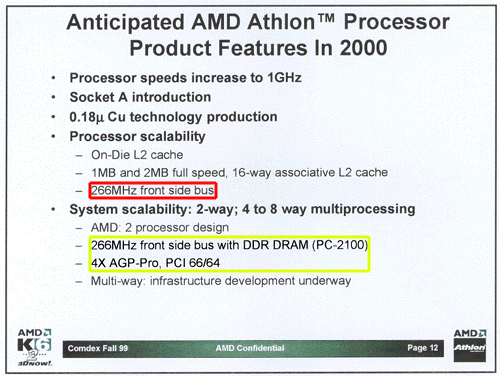Rambus DRAM: Uncovering Facts & Burying Rumors
by Anand Lal Shimpi on May 15, 2000 12:27 AM EST- Posted in
- Memory
The one thing that cannot be argued with is that today's PC is hungry for more memory bandwidth. While it can be disputed that the move to a 133MHz memory bus from the 100MHz standard doesn't yield a huge performance increase, simply looking at the success of the DDR GeForce from NVIDIA in comparison to the originally released GeForce equipped with SDR SDRAM and the performance hit the newly released GeForce 2 GTS takes when storing twice as much information (32-bit color) chews up the "limited" 5.3GB/s of memory bandwidth, you'll quickly agree with the fact that conventional SDRAM simply cannot offer the memory bandwidth necessary for today's applications and games.
But let's get back to a more relevant question: Is there a need for a faster memory solution? Although we could give Intel's estimations for the bandwidth requirements by the end of 2000 and into 2001, we'll go one step further and provide you with data that AMD is publishing as to what kind of system/memory bandwidth requirements systems will begin needing towards the end of 2000 and into 2001.

The Athlon, currently running off of the 1.06GB/s of memory bandwidth provided by PC133 SDRAM, will migrate to a 133MHz DDR FSB (effectively running at 266MHz) toward the end of this year. This translates into about 2.1GB/s of bandwidth present between the CPU and the North Bridge of the chipset (this path is otherwise referred to as the FSB). Combine that with the 1.06GB/s required by AGP 4X and 64-bit PCI running at 66MHz (528MB/s), and you get about 3.7GB/s of bandwidth that the memory interface must be capable of supplying or your AMD based system won't be able to operate at its peak. We just mentioned that the Athlon's PC133 SDRAM can currently only deliver 1.06GB/s of memory bandwidth, and even using DDR SDRAM, you're only going to increase that to 2.1GB/s, still only 57% of the total memory bandwidth we need for our next generation AMD based systems.
The same thing applies to Intel. The 440BX chipset with its PC100 SDRAM is in an even worse position since it only has an available 800MB/s of memory bandwidth. The reason for using AMD as an example here was to prove that this is a real situation and not just some marketing propaganda from Intel to promote their chipsets. AMD knows this too, which is why you don't see any mention of DDR SDRAM beyond their current 2000 roadmap: 2.1GB/s of memory bandwidth isn't enough for next year's computing platforms.










1 Comments
View All Comments
dylan522p - Wednesday, December 11, 2013 - link
Wow I wish I read this all those years ago.